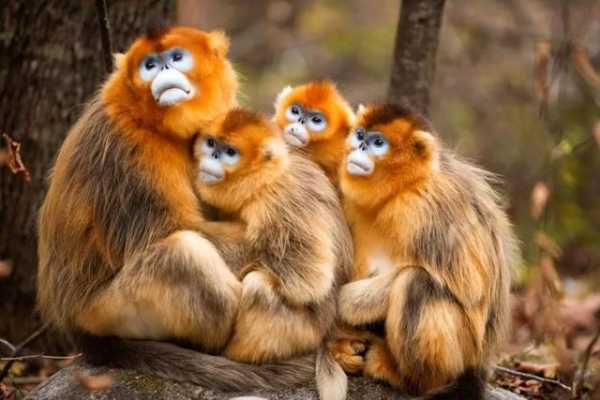Rhinopithecus roxellana
IUCN
LCBasic Information
Scientific classification
- name:Rhinopithecus roxellana
- Scientific Name:Sichuan golden monkey, snub-nosed monkey, snub-nosed monkey, golden velvet monkey, blue-faced monkey, Rockanna monkey, long-tailed monkey, thread monkey, thread marmoset, horse marmoset, Guoran beast,
- Outline:Primates
- Family:Mammalia Primates Cercopithecidae Rhinopithecus
Vital signs
- length:57-76 cm
- Weight:Male weight: 15~39 kg, Female weight: 6.5~10 kg
- lifetime:About 26 years
Feature
The golden hair is particularly dazzling
Distribution and Habitat
The Sichuan golden snub-nosed monkey is only distributed in Sichuan, Gansu, Shaanxi and Hubei in China. The golden snub-nosed monkey is a typical forest arboreal animal, living in forests at an altitude of 1,500 to 3,300 meters all year round. Its vegetation types and vertical distribution zones belong to four vegetation types: subtropical mountain evergreen, deciduous broad-leaved mixed forests, subtropical deciduous broad-leaved forests and evergreen coniferous forests, and secondary coniferous broad-leaved mixed forests. With the change of seasons, they do not migrate horizontally, but only move vertically in their habitats.
Appearance
The Sichuan golden snub-nosed monkey is a medium-sized monkey. Its nostrils are upward, its face is blue, and it has no cheek pouches. Its cheeks and neck are brown-red, its shoulders and back are covered with long hair, and its tail is as long as or longer than its body. The average body length of an adult male is 680mm, and its tail is 685mm.
The Sichuan golden snub-nosed monkey is a diurnal arboreal animal that spends 97% of its time in the canopy. The Sichuan golden snub-nosed monkey can move in small groups of 5-10, or gather in large groups of 600. The social structure of the Sichuan golden snub-nosed monkey is relatively complex. There is usually a leader male monkey leading the group, and there are also multiple groups that gather together to move and forage.
The groups of Sichuan golden snub-nosed monkeys are divided into leader groups, mother-child groups, and bachelor groups. Male monkeys usually move alone and have few social interactions. Adult female monkeys usually
Details
Except for the white hair on the abdomen, buttocks, and the inside of the limbs, the rest of the body of the Sichuan golden snub-nosed monkey is golden yellow. The shoulders and back have long hair from the tail to the buttocks, which is gray-brown, similar to the straw raincoat used by farmers to prevent water from flowing into the body. The adult monkey has blue bare skin on the face, and the whole body is covered with more than 10 cm thick hair. The hair of the juvenile monkey is light gray and light yellow.

The Sichuan snub-nosed monkey is a highly vocal species, with both males and females excelling at certain calls. Male vocal behavior is characterized by whimpers and calls. Female vocal behavior typically includes gurgles and screams. Both sexes indulge in other sounds—grunts, sighs, groans, hiccups—but to a much lesser degree. An interesting aspect of the Sichuan snub-nosed monkey's vocalizations is the ventriloquism that occurs without any body or facial movements. This applies especially to whimpers and screams, with males and females often howling at each other when feeding. In the wild, choral vocalizations involving groups or subgroups are common.
The Sichuan golden snub-nosed monkey has a typical family lifestyle, with members caring for each other, foraging together, playing together and resting together. At home, young Sichuan golden snub-nosed monkeys are very curious, very naughty, and are also loved by their parents, but when young male monkeys grow up, they will be driven out of the house by their fathers and have to live independently in the wild.
The Sichuan golden snub-nosed monkey is of the same origin as humans, and still retains many qualities similar to humans. For example, the shape of the ends of the limbs is similar to that of human hands and feet, the sound of the cry of the baby monkey is similar to that of the cry of a human baby, the posture of the mother monkey holding the baby is the same as that of humans, and especially the mating behavior is carried out throughout the year, which is very different from most other animals and closer to humans.
The golden fur of Sichuan golden snub-nosed monkeys is very beautiful, and they are hunted mainly for their fur; on the other hand, some people mistakenly believe that the meat and bones of Sichuan golden snub-nosed monkeys have medicinal value in some aspects. This makes Sichuan golden snub-nosed monkeys the target of hunting. From 1963 to 1974, when the damage was the most serious, an incomplete statistics showed that 300 were hunted in Sichuan alone.
Deforestation, agricultural and animal husbandry production, human deforestation and grazing in the forest have caused the distribution area of Sichuan golden snub-nosed monkeys to shrink and split, which has interfered with their normal life, so they have been gradually eliminated in some places.
Since the habitat of the Sichuan golden snub-nosed monkey overlaps with that of the giant panda, the protection work of the protected areas established for the protection of the giant panda started earlier, and the publicity and education for the masses was also carried out earlier. Therefore, with the establishment of the protected areas, the population of the Sichuan golden snub-nosed monkey in many places has been restored. Compared with the other two snub-nosed monkeys, the number of the Sichuan golden snub-nosed monkey is the largest. With the complete ban on the felling of natural forests, the habitat of the Sichuan golden snub-nosed monkey has been protected. With the pressure of publicity and regulations, poaching activities have basically disappeared.
CITES endangered level: Appendix I Effective year: 1997
National key protection level: First level Effective year: 1989
China Red Book of Endangered Animals Level: Endangered
Listed in the Red List of Endangered Species of the World Conservation Union (IUCN)








